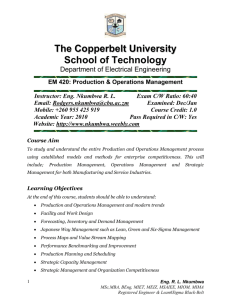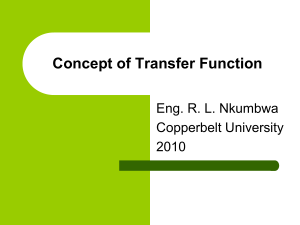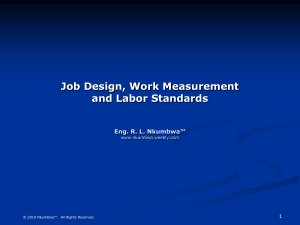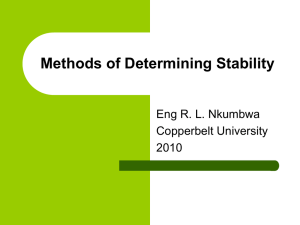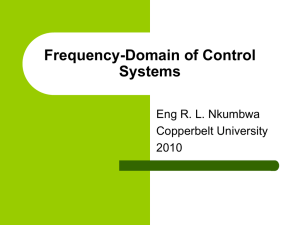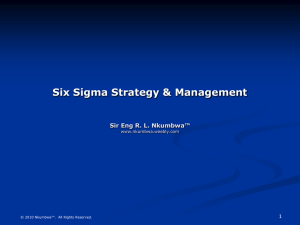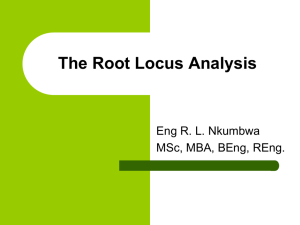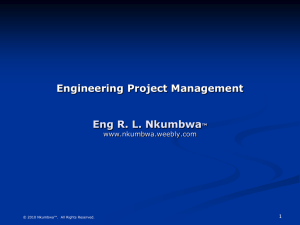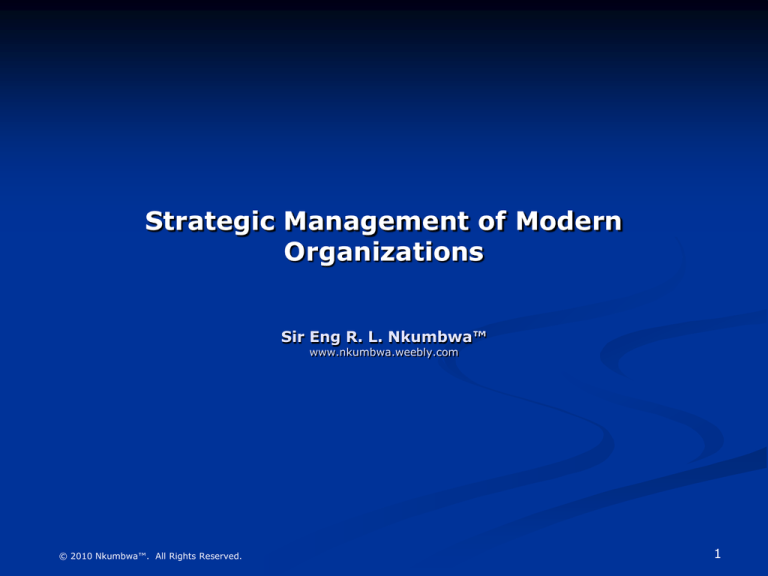
Strategic Management of Modern
Organizations
Sir Eng R. L. Nkumbwa™
www.nkumbwa.weebly.com
© 2010 Nkumbwa™. All Rights Reserved.
1
Outline
Strategic Management Thinking
The Strategic Management Process
Customer Analysis
Competitor Analysis
Strategy Formulation
Execution
© 2010 Nkumbwa™. All Rights Reserved.
2
“Plans are nothing, planning is
everything.”
Dwight D. Eisenhower
© 2010 Nkumbwa™. All Rights Reserved.
3
Strategic Management Thinking
© 2010 Nkumbwa™. All Rights Reserved.
4
Detailed planning
Market intelligence
Choice of battleground
Swiftness in execution of plans
Adaptability in maneuvers
Creation of strategic advantages and
(sustainable competitive advantages)
Attack, if one has to engage in open competition
© 2010 Nkumbwa™. All Rights Reserved.
5
Detailed planning
Market intelligence
Choice of battleground
Swiftness in execution of plans
Adaptability in maneuvers
Creation of strategic advantages and
(sustainable competitive advantages)
Attack, if one has to engage in open competition
© 2010 Nkumbwa™. All Rights Reserved.
6
The Art of
War by Sun
Tzu
Deterministic influence on history in Asia
Japanese military, business, and economic
history
1772 -- France
1991--U.S.
© 2010 Nkumbwa™. All Rights Reserved.
7
The Strategic Management Process
Sun Tzu’s Art of War Model
© 2010 Nkumbwa™. All Rights Reserved.
8
Strategy Formulation
Situation Appraisal
Formulation of Goals
and Strategies
Evaluation of Strategies
Strategy Implementation
Implementation of Strategies
Strategic Controls
© 2010 Nkumbwa™. All Rights Reserved.
9
Actual Examples of Self Examination
(Internal analysis)
Competitive situations ?
Business
Sports
Military
Self improvement?
© 2010 Nkumbwa™. All Rights Reserved.
10
Performance Measures Reflecting
Long-Term Profitability
Source: Strategic Market Management (6th ed.), 2001, by David A. Aaker John
Wiley & Sons, New York
© 2010 Nkumbwa™. All Rights Reserved.
11
Customer Satisfaction/Brand
Loyalty
Product/Service Quality
Brand/Firm Associations
Current
Performance
LongTerm
Profits
Relative Cost
New Product Activity
Manager/Employee Capability and
Performance
© 2010 Nkumbwa™. All Rights Reserved.
12
A Resource-Based (VRIO) Approach
to Internal Analysis
© 2010 Nkumbwa™. All Rights Reserved.
13
Value
?
Imitability
?
Resource
or
Capability
Strength
or
Weakness
Rareness
?
Organization
?
© 2010 Nkumbwa™. All Rights Reserved.
14
1. The Question of Value: Do the firm's resources and
capabilities enable the firm to respond to environmental
threats or opportunities?
2. The Question of Imitability : Do firms without a
resource or capability face a cost disadvantage in obtaining
it compared to firms that already possess it?
3. The Question of Rareness: How many competing firms
already possess particularly valuable resources and
capabilities?
© 2010 Nkumbwa™.
4. The Question of Organization : Is a firm organized to
exploit the full competitive potential of its resources and
capabilities?
All Rights Reserved.
15
Internal (Self) Analysis
Sun Tzu’s proposed 7 questions
Performance-based measures
Resource-based analysis
© 2010 Nkumbwa™. All Rights Reserved.
16
Five Major Ideas for Strategy
from Sun Tzu
© 2010 Nkumbwa™. All Rights Reserved.
17
Strategic Advantage ( shih)
Strategic Positioning (hsing)
According with the Enemy ( yin)
The Exemplary Commander
Foreknowledge (chih)
Th ese five i deas are taken from Sun -Tzu The Art of Warfare, trans late d by
Roge r Ame s, 1 993, Ball anti ne Bo oks , New Yo rk.
© 2010 Nkumbwa™. All Rights Reserved.
18
Strategic Advantage (shih)
© 2010 Nkumbwa™. All Rights Reserved.
19
Changes unique, proceed in pattern
Changing configuration, defining
disposition
Situations turned to advantage
Controlling and shaping situation
Central theme:
Need for flexibility each unique situation
No invariable strategic advantage
"Security" revising redefining strength
© 2010 Nkumbwa™. All Rights Reserved.
Does not resist rhythm of change,
finds its pulse
20
Strategic Advantage (shih)
Process
Outcome
Examples
Sports
Military
Business
© 2010 Nkumbwa™. All Rights Reserved.
21
Strategic Positioning (hsing)
© 2010 Nkumbwa™. All Rights Reserved.
22
Limited to tangible
Connotation of physical,
Fluid
Strategic positioning
Contrast to strategic
advantage (shih)
© 2010 Nkumbwa™. All Rights Reserved.
23
Strategic Positioning (hsing)
Outcome
Process
Examples
Sports
Military
Business
© 2010 Nkumbwa™. All Rights Reserved.
24
According with the Enemy (yin)
© 2010 Nkumbwa™. All Rights Reserved.
25
Responsiveness to one's
context
"Give and take"
Sensitivity
Adaptability
© 2010 Nkumbwa™. All Rights Reserved.
26
According with the Enemy (yin)
Microsoft versus Netscape
"Judo Strategy: The Competitive Dynamics of Internet Time"
from the Harvard Business Review, January - February, 1999,
pp. 70 - 81.
© 2010 Nkumbwa™. All Rights Reserved.
27
“Judo Strategy: Competitive
Dynamics in Internet Time”
Source: Harvard Business Review, January - February, 1999.
© 2010 Nkumbwa™. All Rights Reserved.
28
Useful mindset for small companies competing
with large, better-established companies.
A powerful tool for new or established
businesses, high-tech or low-tech.
Netscape formed, April, 1994.
Netscape Navigator released, December, 1994
December, 1995 - 20 months after formation, company
worth more than $ 7 billion.
November 24, 1998, America Online purchased Netscape
for $4.2 billion, Sun Microsystems a partner in deal as
reseller of Netscape software.
© 2010 Nkumbwa™. All Rights Reserved.
29
Principle #1
Move rapidly to uncontested ground to avoid head-to-head
conflict.
Do...
move to new products that redefine the competitive
space.
move to new pricing models that competitors are unable
to emulate.
move to new testing and distribution models that avoid
competitor's strengths.
© 2010 Nkumbwa™. All Rights Reserved.
30
Principle #1
Move rapidly to uncontested ground to avoid head-to-head
conflict.
Don't...
suppose that constant movement is possible or desirable
allow excessive movement to destroy your focus and
weaken your credibility
assume that speed and time-to-market reduce the
importance of quality to enterprise customers
© 2010 Nkumbwa™. All Rights Reserved.
31
Principle #2
Be flexible and give way when attacked directly by superior force.
Do...
avoid sumo matches unless you're bigger and stronger than
your opponent.
embrace and extend rivals' smart moves.
mesh flexibility and tactical adjustments with long-term
strategic plans.
© 2010 Nkumbwa™. All Rights Reserved.
32
Principle #2
Be flexible and give way when attacked directly by superior force.
Don't...
escalate unwinnable wars.
be afraid to cannibalize your own products.
© 2010 Nkumbwa™. All Rights Reserved.
33
Principle #3
Exploit leverage that uses the weight and strength of
opponents against them.
Do...
turn your opponent's strategic commitments
and investments to your advantage
cooperate with others who are threatened by
your opponent's success
© 2010 Nkumbwa™. All Rights Reserved.
34
Principle #3
Exploit leverage that uses the weight and strength of
opponents against them.
Don't...
forget that the greater your success, the more likely it
is that leverage can be used against you.
© 2010 Nkumbwa™. All Rights Reserved.
35
The Exemplary Commander
© 2010 Nkumbwa™. All Rights Reserved.
36
Exemplary person
Superior character
Characteristics
Wisdom
Integrity
Humanity
Courage
Discipline
© 2010 Nkumbwa™. All Rights Reserved.
37
Foreknowledge ( chih)
© 2010 Nkumbwa™. All Rights Reserved.
38
Set of circumstances
Minute fluctuations
Complex systems rich in
information
Reliable information
Defeat competition with
careful planning rather than
might
© 2010 Nkumbwa™. All Rights Reserved.
39
Foreknowledge ( chih)
Please list examples in each of the following categories:
Sports
Military
Business
Career strategies
© 2010 Nkumbwa™. All Rights Reserved.
40
Strategic Advantage ( shih)
Strategic Positioning (hsing)
According with the Enemy ( yin)
The Exemplary Commander
Foreknowledge (chih)
Th ese five i deas are taken from Sun -Tzu The Art of Warfare, trans late d by
Roge r Ame s, 1 993, Ball anti ne Bo oks , New Yo rk.
© 2010 Nkumbwa™. All Rights Reserved.
41
“Drive thy business (through
strategy) or it will drive thee.”
Benjamin Franklin (1706 - 1790). Poor Richards
Almanac, September 1744.
© 2010 Nkumbwa™. All Rights Reserved.
42
Customer Analysis
Source: Strategic Market Management (6th ed.) by
David A. Aaker.
© 2010 Nkumbwa™. All Rights Reserved.
43
Customer Analysis
Customer segmentation
Customers’ motivations
Customers’ unmet needs
© 2010 Nkumbwa™. All Rights Reserved.
44
Segmentation
Who are the biggest customers?
The most profitable?
The most attractive potential customers?
Do customers fall into any logical groups based on needs,
motivations, or characteristics?
How could the market be segmented into groups that would
require a unique business strategy?
Consider variables such as:
Benefits sought
Usage level
Application
Organization type
Geographic location
Customer loyalty
Price sensitivity
© 2010 Nkumbwa™. All Rights Reserved.
45
Examples of Approaches to Defining
Segments
Customer Characteristics and Product-Related Approaches
© 2010 Nkumbwa™. All Rights Reserved.
46
Customer Characteristics
Geographic Small Southern communities as markets for
discount stores (early Wal Mart)
Type of organization Computer needs of restaurants versus
manufacturing firms versus banks versus retailers
Size of firm
Large hospital versus medium versus small
Lifestyle Jaguar buyers tend to be more adventurous, less
conservative than buyers of Mercedes-Benz and BMW
Sex Mothers of young children
Age Cereals for children versus adults
© 2010 Nkumbwa™.
Occupation The paper copier needs of lawyers versus
All Rights Reserved.
bankers versus dentists
47
Product-Related Approaches
User type
owner
Usage
Appliance buyer - home builder, remodeler, home
The heavy potato user - fast foods outlets
Benefits sought Dessert eaters - those who are calorie
conscious versus those who are more concerned with
convenience
Price sensitivity Price-sensitive Honda Civic buyer versus
the luxury Mercedes-Benz buyer
Competitor Users of competing products
Application Professional users of chain saws versus home
owners
Brand loyalty Those committed to Heinz ketchup versus
price buyers
© 2010 Nkumbwa™. All Rights Reserved.
48
Customer Motivation Analysis
Source: Strategic Market Management, 6th ed. By David A.
Aaker.
© 2010 Nkumbwa™. All Rights Reserved.
49
“The greater part of our daily actions
are the result of hidden motives which
escape our observation.”
Gustave Le Bon (1841 - 1931). The Crowd: A
study of the popular mind. 1.1, 1895, Viking
Press edition, 1960.
© 2010 Nkumbwa™. All Rights Reserved.
50
Customer Motivations
What elements of the product/service do customers value
most?
What are the customers' objectives? What are they really
buying?
How do segments differ in their motivation priorities?
What changes are occurring in customer motivation? In
customer priorities?
© 2010 Nkumbwa™. All Rights Reserved.
51
Identify Motives
Group and Structure Motives
Assess Motivation Importance
Assign Strategic Roles to Motives
Why is the product or service being used?
What is the objective?
What is associated with a good or bad use
experience?
© 2010 Nkumbwa™. All Rights Reserved.
52
Customer Unmet Needs Analysis
© 2010 Nkumbwa™. All Rights Reserved.
53
Unmet Needs
Why are some customers dissatisfied? Why are some
changing brands or suppliers?
What are the severity and incidence of consumer problems?
What are unmet needs that customers can identify? Are
there some of which consumers are unaware?
Do these unmet needs represent leverage points for
competitors?
© 2010 Nkumbwa™. All Rights Reserved.
54
Examining the Fundamentals of Sun Tzu’s
Thinking
Wisdom and Warfare
© 2010 Nkumbwa™. All Rights Reserved.
55
“The hero saves us. Praise the
hero! Now, who will save us
from the hero?”
Cato the Elder (234 - 149 B.C.) Roman Senate speech. In
David Schoenbrun, The Three Lives of Charles de Gaulee,
pt. 2 (epigraph), 1968.
© 2010 Nkumbwa™. All Rights Reserved.
56
The Exemplary Person
© 2010 Nkumbwa™. All Rights Reserved.
57
Is not a functionary
(ch'i)
Pursues harmony (ho)
not sameness
© 2010 Nkumbwa™. All Rights Reserved.
58
Classical Western Assumptions
(A "Two-World" Theory)
© 2010 Nkumbwa™. All Rights Reserved.
59
"Dualistic" mode of thinking
"Real" structure behind change
Classical Greek Philosophy
creates -- created
orders -- ordered
moves -- moved
© 2010 Nkumbwa™. All Rights Reserved.
60
Classical Chinese Assumptions
(A “This-World” View1)
One continuous world
Creativity resides in world
Regularity stems from this
world
© 2010 Nkumbwa™. All Rights Reserved.
Autogenerative, selforganizing, alive
Everything related to, a
condition of every other
person, thing, or event.
61
Classical Chinese Assumptions
(A “This-World” View2)
Classical Greek philosophers,
knowledge “essence” “form”
“foundation” language of
knowledge
Classical Chinese model, not
permanent structure,
mapped within dynamic
process
© 2010 Nkumbwa™. All Rights Reserved.
Site specific regularity and
pattern
Mapping out local conditions
Once understood,
manipulated to anticipate
next moment
Comprehensiveness
62
Classical Chinese Assumptions
(A “This-World” View3)
“Knowing”-- being able to
trace out and manipulate
those conditions far or near
that will affect the shifting
configuration of one’s own
place.
“Battlefield” is alive
© 2010 Nkumbwa™. All Rights Reserved.
Knowing entails “undoing”
(tracing out connections,
discovering patterns,
anticipating what will ensue
next)
The “purpose” of experience
63
Classical Chinese Assumptions
(A “This-World” View4)
Creativity:
classical Western thought
classical Chinese thought
© 2010 Nkumbwa™. All Rights Reserved.
Harmony
64
Centripetal Harmony and
Authority
© 2010 Nkumbwa™. All Rights Reserved.
65
Premise
Authority derived from being at the center
of radial pattern of roles and relationships
As long as the center is strong
Ruler acts imperceptibly appearing to
be unmoved and unmoving
Achievement of harmony a goal of
personal, social, and political development
in classical Chinese tradition
© 2010 Nkumbwa™. All Rights Reserved.
66
Examining the Fundamentals of Sun
Tzu’s Thinking
(Summary)
The exemplary person
Differences between Classical Western Assumptions vs.
Classical Chinese Assumptions
Centripetal harmony and authority
Warfare [competition and the development of competitive
strategy] as the art of contextualizing
© 2010 Nkumbwa™. All Rights Reserved.
67
Competitor Analysis
Identify who are the competitors
Categorize into strategic groups
Evaluate competitors’ strategies
Analyze threat of potential competitors
Understand competitors’ actions
© 2010 Nkumbwa™. All Rights Reserved.
68
Who are the competitors?
Against whom do we usually compete?
Who are our most intense competitors?
Less intense but still serious competitors?
Makers of substitute products?
Can these competitors be grouped into strategic groups
on the basis on their assets, competencies and/or
strategies?
Who are the potential competitive entrants?
What are their barriers to entry?
Is there anything that can be done to discourage them?
© 2010 Nkumbwa™. All Rights Reserved.
69
Identifying Strategic Groups
Over time pursue similar
competitive strategies (e.g., use of
the same distribution channel and
heavy advertising)
Have similar
characteristics (e.g., size,
aggressiveness).
Have similar assets and
competencies (e.g., quality
image)
© 2010 Nkumbwa™. All Rights Reserved.
70
Evaluating the Competitors'
Strategies
© 2010 Nkumbwa™. All Rights Reserved.
71
What are their objectives and strategies?
Their level of commitment?
Their exit barriers?
What is their cost structure?
Do they have a cost advantage or disadvantage?
What is their image and positioning strategy?
Which are the most successful/unsuccessful competitors over
time?
Why?
What are the strengths and weaknesses of each competitor or
strategic group?
What leverage points (our strategic weaknesses or customer
problems or unmet needs) could competitors exploit to enter the
market or become more serious competitors?
Evaluate the competitors with respect to their assets and
competencies. Generate a competitor strength grid.
© 2010 Nkumbwa™. All Rights Reserved.
72
Potential Competitors
Market Expansion
Product Expansion
Backward Integration
Forward Integration
The export of assets or skills
Retaliatory or defensive strategies
© 2010 Nkumbwa™. All Rights Reserved.
73
Image and
Positioning
Size, Growth
and Profitability
Strengths
and
Weaknesses
Objectives
and Commitment
Competitor
Actions
Current and
Past
Strategies
Organization
and
Culture
Exit Barriers
Cost
Structure
© 2010 Nkumbwa™. All Rights Reserved.
74
Competitor Analysis
Summary
Identify competitors
Categorize into strategic
groups
Evaluate competitors’
strategies
© 2010 Nkumbwa™. All Rights Reserved.
Analyze threat of potential
competitors
Understand competitors’
actions
75
How to Conduct a Market Analysis
© 2010 Nkumbwa™. All Rights Reserved.
76
Market Analysis
Size and growth
Profitability
Cost structure, distribution systems, and trends
Key success factors
Porter’s Five-Factor Model of Profitability
© 2010 Nkumbwa™. All Rights Reserved.
77
Size and Growth
What are the important and potentially important submarkets?
What are their size and growth characteristics?
What submarkets are declining or will soon decline?
How fast?
What are the driving forces behind sales trends?
© 2010 Nkumbwa™. All Rights Reserved.
78
Profitability
For each major submarket, consider:
Is this a business area in which the average firm will make
money?
How intense is the competition among existing firms?
Evaluate the threats from potential entrants and substitute
products.
What is the bargaining power of suppliers and customers?
How attractive/profitable are the market and its
submarkets now and in the future?
© 2010 Nkumbwa™. All Rights Reserved.
79
Cost Structure
Distribution Systems
Trends
What are the major cost and value-added components for
various types of competitors?
What are the alternative channels of distribution?
How are they changing?
What are the various trends in the market?
© 2010 Nkumbwa™. All Rights Reserved.
80
Key Success Factors
What are the key success factors, assets, and
competencies needed to compete successfully?
How will these change in the future?
How can the assets and competencies of
competitors be neutralized by strategies?
© 2010 Nkumbwa™. All Rights Reserved.
81
Strategic necessities -Must be present in order to
compete. Absence will create
a substantial weakness.
(direct forces - actions)
Key Success
Factors -Assets and
competencies
that provide the
bases for
competing
successfully.
Strategic strengths-Assets or competencies that
are superior to the
competition. Provide the
basis for an advantage.
(indirect forces - actions)
© 2010 Nkumbwa™. All Rights Reserved.
82
How to Determine
Key Success
Factors
Dissect the market
and identify key
success elements
© 2010 Nkumbwa™. All Rights Reserved.
Discover
characteristics that
distinguish winners
from losers.
83
Key Success Factors
Identify
Inject concentration of resources
into particular area with
opportunity for gaining most
significant strategic advantage.
Bring resources to bear on
one critical point
Can create competitive success with fewer resources overall.
© 2010 Nkumbwa™. All Rights Reserved.
84
Threat of Potential
Entrants
Bargaining
Power
of
Suppliers
Competition Among
Existing Firms
Bargaining
Power of
Customers
Threat of Substitute
Products
Porter’s Five-Factor Model of Market Profitability
© 2010 Nkumbwa™. All Rights Reserved.
85
Market Analysis
(Summary)
Size and growth
Profitability
Cost structure, distribution systems, and trends
Key success factors
Porter’s Five-Factor Model of Profitability
© 2010 Nkumbwa™. All Rights Reserved.
86
How to Conduct an Environmental
Analysis
© 2010 Nkumbwa™. All Rights Reserved.
87
Technology
Government
To what extent are existing technologies maturing?
What technological developments or trends are affecting or could
affect the industry?
What changes in regulation are possible? What will their impact
be?
What tax or other incentives are being developed that might affect
strategy?
What are the political risks of operating in a government
jurisdiction?
© 2010 Nkumbwa™. All Rights Reserved.
88
Economics
Culture
Demographics
What are the economic and inflation prospects in
the markets in which the company operates?
How will these prospects affect strategy?
What are the current or emerging trends in
lifestyles, fashions, and other components of
culture? Why are these trends occurring? What
are their implications?
What demographic trends will affect the market
size of the industry or its submarkets?
What demographic trends represent opportunities
or threats?
© 2010 Nkumbwa™. All Rights Reserved.
89
General External Analysis Questions
What are the significant trends and future events?
What are some present and future treats and
opportunities?
What are the key areas of uncertainty that have
the potential to impact strategy? Evaluate the
strategic uncertainties in terms of their potential
impact.
What strategic uncertainties merit being the basis
of a scenario analysis?
Source: Strategic Market Management by David A. Aaker, 6th ed.
© 2010 Nkumbwa™. All Rights Reserved.
90
Environmental Analysis
(Summary)
Technology
Government
Economics
Culture
Demographics
Trends, future events and strategic uncertainties
© 2010 Nkumbwa™. All Rights Reserved.
91
“By losing your goal - you have lost
your way, too!”
Friedrich Nietzsche (1844 - 1900) “The
Shadow,” Thus Spoke Zarathustra, 1892, tr. R.
J. Hollingdale, 1961
© 2010 Nkumbwa™. All Rights Reserved.
92
Formulation of Goals
© 2010 Nkumbwa™. All Rights Reserved.
93
Prioritize Goals
Next
Best
Next
Attack
the
enemy's
strategy
© 2010 Nkumbwa™. All Rights Reserved.
Disrupt
the
enemy's
alliances
Worst
Attack
the
enemy's
army
Besiege
walled
cities
94
Attack the enemy's strategy
(preemptive move)
Introduce superior product or
service earlier
Enter new market segments
earlier
Enter foreign markets earlier
© 2010 Nkumbwa™. All Rights Reserved.
95
Disrupt the enemy's
alliances
Break up or
Prevent alliances from forming
(difficult)
Form strategic alliances as a method of increasing your
strength or diversifying risk.
© 2010 Nkumbwa™. All Rights Reserved.
96
Attack the enemy's army
Capture key officers or personnel
Upset the morale of enemy troops
Burn or cut off supplies
Attack enemy forces and/or conduct periodic raids
Military annexation (acquisitions)
© 2010 Nkumbwa™. All Rights Reserved.
97
Besiege Walled Cities 1
Victory likely to be long delayed
Morale of army depressed
Troops exhausted
Resources may not be sufficient
© 2010 Nkumbwa™. All Rights Reserved.
98
Besiege Walled Cities 2
Product not differentiated
Avoid open
market
competition
if
if
Market not growing
© 2010 Nkumbwa™. All Rights Reserved.
99
Achievable Goals
Choose right
competitors to attack
© 2010 Nkumbwa™. All Rights Reserved.
Accomplish goals
within "reasonable"
time frame (closeended always)
100
Net Positive Gains
Quantitative Gains
© 2010 Nkumbwa™. All Rights Reserved.
Qualitative Gains
101
To achieve maximum gains with
minimum effort, goals must
Be prioritized
Be achievable
Result in net positive gains
© 2010 Nkumbwa™. All Rights Reserved.
102
Formulation of Strategies
Principle of concentration of forces
Principle of attack
© 2010 Nkumbwa™. All Rights Reserved.
103
Principle of Concentration of Forces
© 2010 Nkumbwa™. All Rights Reserved.
104
Relative
strength
not
Absolute
strength
Point of
contact
Dictates
outcomes
Choice of battleground
achie ve d
Relative
Superiority
achie ve d
Maintaining strict secrecy of
battle plans
achie ve d
Using deception
© 2010 Nkumbwa™. All Rights Reserved.
105
Not fixed e.g., "terrain"
Variable maneuvered and
managed
Battleground
choice
Areas ignored by competition
Areas - competitive advantage (based
on internal analysis and comparison
of attributes.)
© 2010 Nkumbwa™. All Rights Reserved.
106
Guard
business,
marketing,
R&D,
strategies,
etc.
Secrecy of
battle plans
Prevents
competitors'
preemptive
moves
© 2010 Nkumbwa™. All Rights Reserved.
East vs. West
107
Not as a way of
doing business
Use
deception
Send "wrong" signals to
competitors, hope to
achieve surprise,
gain advantage
© 2010 Nkumbwa™. All Rights Reserved.
108
Principle of Attack
© 2010 Nkumbwa™. All Rights Reserved.
109
War is to be
avoided
If unavoidable, only
way to win
"attack"
Times of "peace", no active
battles,
strengthen one's resources
(consolidate gains)
strengthen defenses
© 2010 Nkumbwa™. All Rights Reserved.
110
Develop a competitive advantage
Increase product usage
Some growth
strategies,
methods of
attack for
existing
products
Expand to new markets
Tactical actions
© 2010 Nkumbwa™. All Rights Reserved.
111
Increase the frequency
of use/consumption
Increase
product
usage
Increase the level of
use (quantity used)
Find new applications
for current users
© 2010 Nkumbwa™. All Rights Reserved.
112
Increase Frequency of Use/Consumption
Provide reminder communications
Position for frequent use
Position for regular use
Make the use easier or more
convenient
Provide incentives
Reduce undesirable consequences of
frequent use
Jell-O Pudding
Shampoo, car care
Flossing teeth after meals
Dixie-cup dispenser, microwavable
Frequent-flyer, frequent-eater plans
Gentle shampoo
Source: Strategic Market Management by David A. Aaker, (5th edition)
© 2010 Nkumbwa™. All Rights Reserved.
113
Increase Level of Use/Consumption
Increase Level of Use/Consumption
Provide reminder communications
Provide incentives
Influence norms
Reduce undesirable consequences of
increased use level
Develop positive associations with use
occasions
Increase insurance coverage
Special price for accessories
Use of larger containers
Low-calorie candy
Frito-Lay: “Bet you can’t eat just one.”
Source: Strategic Market Management by David A. Aaker, (5th edition)
© 2010 Nkumbwa™. All Rights Reserved.
114
New Applications
Use on different occasions
Use at different locations
Use for different purposes
Cereal as snack versus breakfast
Radio in shower
Baking soda for odor control
Source: Strategic Market Management by David A. Aaker (5th edition)
© 2010 Nkumbwa™. All Rights Reserved.
115
Develop a competitive advantage
Increase product usage
Some growth
strategies,
methods of
attack for
existing
products
Expand to new markets
Tactical actions
© 2010 Nkumbwa™. All Rights Reserved.
116
Expand to new markets
Expand geographically
Target new segments
Usage- target nonusers
Distribution channel - open up second or
third distribution channel (another brand
name)
Age/sex - sell product to varying ages, the
opposite sex
Attribute preference - change (enhance or
lower) features to sell a different market.
Source: Strategic Market Management by David A. Aaker (5th edition)
© 2010 Nkumbwa™. All Rights Reserved.
117
Tactical Actions
Increase advertising
Promotional campaigns
Cut prices (without a sustained competitive advantage)
© 2010 Nkumbwa™. All Rights Reserved.
118
“When” to Attack
Surround enemy
"When outnumbering the enemy ten to one ..."
Direct attack
"When five to the enemy's one... "
Divide enemy
"When double enemy's strength..."
Make a strategic decision to engage
"'When evenly matched, you may choose to fight."
Prepare for retreat
"When slightly weaker than the enemy..."
Avoid enemy
"When greatly inferior..."
© 2010 Nkumbwa™. All Rights Reserved.
119
Ways a Smaller Force Can Win in
Battle
© 2010 Nkumbwa™. All Rights Reserved.
120
Create advantages by seizing opportunities
(something treasured)
Choose areas in which one has distinct
advantages (e.g., Key ground - selection of
battleground)
Areas ignored by the enemy
Find a niche and develop quality (product and/
or service)
© 2010 Nkumbwa™. All Rights Reserved.
121
Principle of Concentration of Forces
Choice of Battleground
Relative
superiority
Maintaining
secrecy of plans
Using deception
© 2010 Nkumbwa™. All Rights Reserved.
122
Principle of Attack
Develop a competitive advantage
Increase product usage
Some
growth
strategies
for existing
products
Expand to new markets
Tactical actions
Ways a smaller force
can win in battle
© 2010 Nkumbwa™. All Rights Reserved.
123
Subjective Evaluation
© 2010 Nkumbwa™. All Rights Reserved.
124
Purpose of Evaluation
To ensure strategy:
Effective
Provides greatest chance of victory
Results in tangible gains
© 2010 Nkumbwa™. All Rights Reserved.
125
Subjective Evaluation
Acquire sense
of strategic
timing
Select strategic
target
Fit strategy to
situation
© 2010 Nkumbwa™. All Rights Reserved.
Create strategic
advantage
126
Select Strategic Target
© 2010 Nkumbwa™. All Rights Reserved.
127
Easy prey
Superiority in numbers
Battleground
Distinct advantage
Area(s) ignored
Sites (areas) poorly defended
Lure enemy to where you want to do battle
Discourage combat in given area
© 2010 Nkumbwa™. All Rights Reserved.
128
Select Strategic Target
(examples)
Target
area
Enter new (e.g.,
foreign) market
Target
customer
New market
segment
Target
competitor
Acquire
competitor
© 2010 Nkumbwa™. All Rights Reserved.
129
Select Strategic Target
Implications of capturing target?
Will company become stronger?
Enough resources to make the move (numerical superiority)?
Target "easily" acquired?
Enhance market positioning (image)?
Improve product/service quality or quantity?
Personnel implications?
Plant?
Machinery?
Money?
Processes
etc.?
© 2010 Nkumbwa™. All Rights Reserved.
130
Fit Strategy to the Situation
© 2010 Nkumbwa™. All Rights Reserved.
131
Criteria to be addressed1
Consistent with
environment
(weather)
Government policies
Business cycles
Social and cultural norms
Opportunities in marketplace
Marketing windows
Technology
Labor
Current political leadership
Weigh effects of
competition (Know
the enemy)
Correct appraisal of competitors
Competitive responses
Vulnerability from a particular
competitor(s)
Head-on collision with dominant players
© 2010 Nkumbwa™. All Rights Reserved.
132
Criteria to be addressed2 continued
Consistent with
corporate practice
and culture
(Doctrine and law)
Mission, philosophy or
values
Organization structure
and processes
Existing know-how
Consistent with
quantity and quality
or resources
Funds to ensure implementation?
Plant?
Equipment?
Technology?
Personnel
(Managers,
Rank and file)
© 2010 Nkumbwa™. All Rights Reserved.
133
Criteria to be addressed3 continued
Acceptable level
of risks
Do not move unless there are
definite advantages to be gained
Match strategy with
market niches and
opportunities
Exploit opportunities offered by
market place
Understand characteristics of
market structure
© 2010 Nkumbwa™. All Rights Reserved.
134
Criteria to be addressed4 - continued
Effective and
efficient
implementation
Timing
Coordination and control
processes for
implementation
Avoid over-used
strategies and tactics
Not a re-hash of
overused methods.
© 2010 Nkumbwa™. All Rights Reserved.
135
Fit Strategy to Situation
Criteria
© 2010 Nkumbwa™. All Rights Reserved.
Consistent
Yes/No
N.A.
Changes
Needed
Comments
136
Create Strategic Advantage
© 2010 Nkumbwa™. All Rights Reserved.
137
How to avoid confrontation with a larger force:
Keep a low
profile
Clever choice
of
battleground
© 2010 Nkumbwa™. All Rights Reserved.
Not attract animosity, jealousy, envy of
enemy.
Reviewed earlier
(Use skill along with thorough
understanding of weather,
general will be able to exploit
terrain to maximum
advantage.)
138
How to avoid confrontation with a larger force - continued
Seize something
of value
© 2010 Nkumbwa™. All Rights Reserved.
May hold patents,
copyrights,
trademarks, designs,
contracts, or
technology desired by
larger force.
139
Three Generic Strategies
Focus niching
Low-cost
Differentiation
tactic
tactics
economies of scale
low overhead
avoid marginal accounts
minimize R & D
minimize service
minimize sales force
minimize advertising and
promotion
Lower costs relative to
competitors
© 2010 Nkumbwa™. All Rights Reserved.
tactics
Serve
particular
target group
very well.
unique to industry
features
distribution
technology
other dimensions
140
Additional Low-cost Strategies
No-frills product/service
Product design
Raw materials cost advantage
Low-cost distribution
Labor cost advantage
Government subsidy
Location cost advantage
Production innovation and automation
Purchase of inexpensive capital equipment
Reduction of overhead
Low-cost culture
© 2010 Nkumbwa™. All Rights Reserved.
141
Three Generic Strategies
Focus niching
Low-cost
Differentiation
tactic
tactics
economies of scale
low overhead
avoid marginal accounts
minimize R & D
minimize service
minimize sales force
minimize advertising and
promotion
Lower costs relative to
competitors
© 2010 Nkumbwa™. All Rights Reserved.
tactics
Serve
particular
target group
very well.
unique to industry
features
distribution
technology
other dimensions
142
Relatively better understanding of
corporate resources and skills
(know yourself)
competitor strengths and weaknesses
(know the enemy)
market characteristics
(know the terrain)
target market or customer group
(the objective)
right market, or product/service, or dimensions for competing
(choice of battleground)
© 2010 Nkumbwa™. All Rights Reserved.
143
Acquire Sense of Strategic Timing
© 2010 Nkumbwa™. All Rights Reserved.
144
Timing affects
The
movement
of troops
and supplies
Deployment
and equipping
of troops
Use of
specific
weapons
Exact
moment of
engagement
Sequence and timing must be right
© 2010 Nkumbwa™. All Rights Reserved.
145
Subjective Evaluation
Acquire sense
of strategic
timing
Select strategic
target
Fit strategy to
situation
© 2010 Nkumbwa™. All Rights Reserved.
Create strategic
advantage
146
Implementation: The Human Factor
© 2010 Nkumbwa™. All Rights Reserved.
147
Implementation: The Human Factor
Human factor - a clear understanding of the roles and
responsibilities in the combat mission.
The
Sovereign
The Army
The
Commander
© 2010 Nkumbwa™. All Rights Reserved.
148
The Sovereign
© 2010 Nkumbwa™. All Rights Reserved.
149
The
Sovereign
analogous to
Stockholders
(Investors)
(Owners)
Misfortune occurs:
"When ignorant that the army should not advance, to order an
advance; when ignorant that the army should not retreat, to
insist on a retreat. This is interference with military command."
"When ignorant of the internal affairs of the military, to
participate and interfere with its administration.
This causes officers and men to be perplexed."
"When ignorant of matters relating to the exercise of military
authority, to interfere in the execution of responsibilities and
command.
This creates doubts in the minds of officers and men."
© 2010 Nkumbwa™.
All Rights Reserved.
150
The Commander
© 2010 Nkumbwa™. All Rights Reserved.
151
Five Dangerous Traits of a Commander
Reckless,
can be killed
Cowardly, can
be captured
Quick-tempered,
can be easily
provoked
Sensitive to
honor, can be
easily insulted
© 2010 Nkumbwa™. All Rights Reserved.
Over
compassionate to
the people, can be
easily harassed.
152
Command is a matter of:
Wisdom
Integrity
Humanity
Courage
Discipline
© 2010 Nkumbwa™. All Rights Reserved.
153
Summary of Positive and Negative Attributes
Caution in
action
Courage in
battle
Composure
under stress
Pragmatism in
decision making
and actions
© 2010 Nkumbwa™. All Rights Reserved.
Sincerity in the
treatment of
subordinates
154
Indecisive or slow to act
Caution - Detailed and thorough planning and execution
Ability to plan, especially planning strategies
whom to fight,
why,
when,
where (or perhaps not to fight)
how.
Ability to execute plans effectively
Ability to manage the army
© 2010 Nkumbwa™. All Rights Reserved.
155
Courage
Accept credit for success and
achievement, and responsibility of
for failure and defeat.
No scapegoats
© 2010 Nkumbwa™. All Rights Reserved.
156
Composure
The capable general
Composed, not easily provoked into anger
and action
Not quick-tempered nor succumbs to pride
and egotism
Not make rash and reckless decisions.
© 2010 Nkumbwa™. All Rights Reserved.
157
Pragmatism
"If the situation is one of victory, the general must fight
even though the ruler may have issued orders not to
engage. If the situation is one of defeat, the general must
not fight even though the ruler may have issued orders to
do so."
Pragmatic strategy formulation and implementation:
Do not be constrained by plans,
if necessary to make changes,
do so without hesitation.
Changes:
competition, consumer tastes and demands, technology and
innovation, suppliers' pressures, government rules and
regulations. environmental shifts, etc.
© 2010 Nkumbwa™. All Rights Reserved.
158
Sincerety
Guard against overcompassion
Maintain objectivity and impartiality in judgment
Administer rewards and punishments equitably
Understand minimum level of performance for each
position.
Maintain exemplary lifestyle (Lead by example)
Ensure compatibility of interests between shareholders,
organization, CEO, and employees
© 2010 Nkumbwa™. All Rights Reserved.
159
The Army
© 2010 Nkumbwa™. All Rights Reserved.
160
Includes all officers and enlisted personnel
Management of army:
training,
superiority at point of engagement,
structure and organization,
motivation,
communication,
combat readiness.
© 2010 Nkumbwa™. All Rights Reserved.
161
Effective Communications System
Progress of
Battle
Condition of the
Enemy
Condition of the Army
© 2010 Nkumbwa™. All Rights Reserved.
162
Effective Communications System
Situational Factor
(Appropriate for situation at hand)
Identifiable to one particular force
(Not confusing among combatants)
Use more than one means to convey messages
(Reduces risk of failure)
Unify all target audiences in the system
Multiply efforts of personnel
(Must be well understood by system users)
Should be flexible and adaptable
© 2010 Nkumbwa™. All Rights Reserved.
163
Morale
Must be high to win battles
Physical Issues
Working conditions-- pay, incentives, medical
benefits, physical environment, vacation time,
childcare, etc.
Psychological Issues
Interesting challenging work and opportunities,
appropriate requirement of skills, knowledge, training;
room for personal improvement, sense of benefiting
fellow human beings; efforts are appreciated.
Emotional Issues
Establish corporate (organizational) loyalty
Ensure compatibility of interests between higher levels
of management and lower levels.
© 2010 Nkumbwa™. All Rights Reserved.
164
Implementation: The Human Factor
Human factor - a clear understanding of the roles and
responsibilities in the combat mission.
The
Sovereign
The Army
The
Commander
© 2010 Nkumbwa™. All Rights Reserved.
165
Implementation: The Operational
Factor
© 2010 Nkumbwa™. All Rights Reserved.
166
Operational factor - certain principles required
to ensure successful implementation of the mission.
Major Principles
Deceptiveness
in actions and
strategies
Swiftness in
execution
Adaptability in
maneuvers
Two Additional Aspects
Capitalize on available
means
© 2010 Nkumbwa™. All Rights Reserved.
Anticipate
competitor's reactions
&
environmental
changes
167
Swiftness in Execution
© 2010 Nkumbwa™. All Rights Reserved.
168
After the plan is decided upon and formalized,
execute expediently
Some consequences of delay:
leakages of plan,
opportunities for competitors to "read" maneuvers,
time to prepare defenses against initiative,
dilutes element of "surprise", lose effect of competitors'
unpreparedness.
© 2010 Nkumbwa™. All Rights Reserved.
169
Swiftness in Execution
Avoid Protracted
Campaigns
Timing
Momentum
© 2010 Nkumbwa™. All Rights Reserved.
170
Attack at most appropriate and suitable moment.
Application of timing, art, not science.
CEO's sense of timing for implementation,
improved by:
strengths and weaknesses of company, relative
to competitors
characteristics of target audience
nature of competition market structure, number, types of competitors, etc.
operating environment political, legal, social, physical, infrastructure, etc.
© 2010 Nkumbwa™.
experiences of company in similar situations in the
All Rights Reserved.
past
171
Momentum
Used to achieve synergy of actions:
to
Overwhelm
competitor(s)
to
Deny competitor(s) benefit
of time to develop effective
defenses and retaliatory
measures.
Create, sustain, and if possible amplify.
Easily applicable to other areas.
© 2010 Nkumbwa™. All Rights Reserved.
172
Avoid protracted campaigns
Early completion allows state (company) to:
Conserve and consolidate resources
Deny competitors opportunity for retaliation
Prevent third parties from interfering and taking
advantage of situation.
For example, prolonged price wars, discounts, etc.
Complete entire mission in shortest time possible.
© 2010 Nkumbwa™. All Rights Reserved.
173
Adaptability in Maneuvers
© 2010 Nkumbwa™. All Rights Reserved.
174
Something can and will go wrong
Not carried away by fast moving events
Not overwhelmed by numerous changing situations
At least 3 aspects
Shaping and
flexibility
Use of
initiative
Innovation
© 2010 Nkumbwa™. All Rights Reserved.
175
Shaping and flexibility
Strategies and tactics that can be revised instantly in response
to situation
Direct and indirect forces -and approaches -to increase
flexibility
Fluidity renders army unpredictable to enemy, more capable of
element of surprise
Business - not rigidly stick to one plan or course of action.
Alternatives should always be available
e.g., contingency planning, sensitivity analysis, scenario
development, etc.
© 2010 Nkumbwa™. All Rights Reserved.
176
Innovation
Use of new approaches :
prevent enemy (competitors) from anticipating
plans; through continual innovation.
Adopted strategy - novel and situation
dependent, rather than relying on "old" proven
strategies.
Shaping and flexibility => reactive flow, according to the situation.
Innovation => proactive, attempts to dictate the situation.
© 2010 Nkumbwa™. All Rights Reserved.
177
Possible tools for innovation
Value chain analysis
Brainstorming
Role playing
Etc.
© 2010 Nkumbwa™. All Rights Reserved.
178
Use of initiative
Requires both proactive and reactive dimensions:
responsiveness to changes in situation
preemptive action
Requires commander to make decisions at the
point of battle
Exercise of initiative in business must be properly monitored.179
© 2010 Nkumbwa™. All Rights Reserved.
Adaptability in Maneuvers
At least 3 aspects
Shaping and
flexibility
Use of
initiative
Innovation
© 2010 Nkumbwa™. All Rights Reserved.
180
Operational factor - certain principles required
to ensure successful implementation of the mission.
Major Principles
Deceptiveness
in actions and
strategies
Swiftness in
execution
Adaptability in
maneuvers
Two Additional Aspects
Capitalize on available
means
© 2010 Nkumbwa™. All Rights Reserved.
Anticipate
competitor's reactions
&
environmental
changes
181
Deceptiveness in Actions and
Strategies
© 2010 Nkumbwa™. All Rights Reserved.
182
"All warfare is based on deception."
"The enemy must not know where I intend to
attack. For if he does not know where I intend
to attack, he must defend in many places. The
more places he defends, the more scattered are
his forces and the weaker is his force at any
one point."
© 2010 Nkumbwa™. All Rights Reserved.
183
Desirable to have relative superiority of:
technology
forces
equipment
At the point of engagement
© 2010 Nkumbwa™. All Rights Reserved.
184
Two ways to achieve relative superiority once battle begins:
Conceal
intentions,
keeping
enemy guessing
where you will
attack/defend.
© 2010 Nkumbwa™. All Rights Reserved.
Use deceptive tactics
to deliberately mislead
enemy; - misdirect
combat power reduce focus on your
true target.
[Allows a smaller
force to handle a
larger force, - speedy
completion of combat
mission.]
185
Purpose of deception: to distract enemy (competitor) and disperse
his combat power. [Also to lull]
Ways to employ deception.
Baits
Illusions
Fakery
Use of
multiple
courses of
action
© 2010 Nkumbwa™. All Rights Reserved.
186
Baits -- methods for bringing competitor … where you want to engage
Lure enemy out of strongholds to
pursue attacking troops; force to fight
in unfamiliar terrain.
e.g., giveaways designed to generate
complacency and to lower defenses.
Spatial advantage and temporal advantage (takes time regather and
© 2010 Nkumbwa™. All Rights Reserved.
reorganize for effectiveness.
187
Illusions and fakery
Illusions -- serve to confuse
enemy about real intentions.
[Although facing same
competitor each time, requires
continual competitive
assessments of you.. requires
time and resources]
© 2010 Nkumbwa™. All Rights Reserved.
Faking -- especially through
false pretenses of
incapability, vulnerability,
humility, and weakness.
188
Illusions and fakery - continued
"Therefore, when capable, feign incapacity; when active, feign
inactivity. When near to the objective, feign that you are far
away; when far away, make it appear that you are near."
© 2010 Nkumbwa™. All Rights Reserved.
189
Unpredictable or multiple courses of action.
Surprise -catches competitor off guard / unprepared
Direct and indirect forces - either can be a decoy, while other
is main force.
Direct and indirect forces -- deployment of troops during
campaign; roles and activities
Direct and indirect approaches -- concerns the use of
strategies
Develop contingency plan in case master plan fails
© 2010 Nkumbwa™. All Rights Reserved.
190
Ways to employ deception.
Baits
Illusions
Fakery
Use of
multiple
courses of
action
© 2010 Nkumbwa™. All Rights Reserved.
191
Operational factor - certain principles required
to ensure successful implementation of the mission.
Major Principles
Deceptiveness
in actions and
strategies
Swiftness in
execution
Adaptability in
maneuvers
Two Additional Aspects
Capitalize on available
means
© 2010 Nkumbwa™. All Rights Reserved.
Anticipate
competitor's reactions
&
environmental
changes
192
Capitalize on Available Means
© 2010 Nkumbwa™. All Rights Reserved.
193
Technology available
400 - 320 B.C.
Fire -- used to
reduce enemy's
strength before actual
engagement
© 2010 Nkumbwa™. All Rights Reserved.
Water -- used to
isolate the enemy via
flooding. Required
superiority of forces
in event of combat.
194
Exploit whatever means available , including:
technology, automation techniques, management skills and
techniques, production facilities, and productivity tools.
© 2010 Nkumbwa™. All Rights Reserved.
195
Anticipate Enemy Reactions and
Environmental Changes
© 2010 Nkumbwa™. All Rights Reserved.
196
Create strong defenses before going on
offensive
Develop contingency plans
Some possible reactions by the enemy
(competitor)
Launch counteroffensive
© 2010 Nkumbwa™. All Rights Reserved.
Develop strong
lines of defense
Use deception
197
Possible changes in the weather
Adverse
weather
can affect
can affect
the
advancement
of troops
date and mode
of final assault
Changes in:
laws, economy, interest rates, politics, regulations, etc.
© 2010 Nkumbwa™. All Rights Reserved.
[threats or opportunities]
198
Operational factor - certain principles required
to ensure successful implementation of the mission.
Major Principles
Deceptiveness
in actions and
strategies
Swiftness in
execution
Adaptability in
maneuvers
Two Additional Aspects
Capitalize on available
means
© 2010 Nkumbwa™. All Rights Reserved.
Anticipate
competitor's reactions
&
environmental
changes
199

